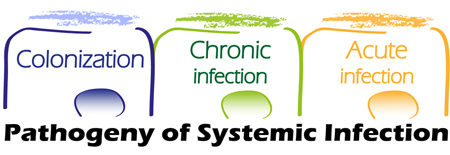Introduction
Systemic infections are characterized by the ability of infecting pathogens to colonize and to disseminate from their port-of-entry into the bloodstream. Two types of bacterial pathogens disseminate beyond their port-of-entry.
- the extra cellular pathogens that can survive in the extracellular fluids and have developed attributes that prevent phagocytosis by polymorphonuclear cells and killing by the serum. These bacteria are essentially those responsible for sepsis that remains a life-threatening condition and a major contributor of public health and economic burden in the industrialized world. These pathogens are in direct contact with endothelial cells. Much remain to be understood on the mechanisms and consequences of this bacterial interaction with the capillaries, even though this interaction is a prerequisite for metastatic dissemination (crossing of the blood brain barrier for example).
- The intracellular pathogens that disseminate in the body using a Trojan horse such as macrophages. The mechanisms by which these latter pathogens resist to the bactericidal Intracellular environment have long been studied. On the other hand, these pathogens often critically rely on acquisition of host-derived nutrients for the development of a successful infection. Since nutrient availability depends on host metabolism and differs depending on localization within tissues and varies over the course of infection, intracellular pathogens have had to adapt their metabolism to these host metabolic rearrangements.
Objectives
Three main research axes are being pursued.
- The first approach focuses on the mechanisms and consequences of the interaction of extra-cellular bacterial pathogens with endothelial cells using Neisseria meningtidis as paradigm. This pathogen following bloodstream invasion from the nasopharynx establishes a strong interaction with the capillaries. This interaction is associated with the occurrence of meningitis and Purpura fulminans. Our objectives are to provide a coherent picture of meningococcal pathogenesis by dissecting the interaction between meningococci and endothelial cells at the molecular, cellular, and tissular levels.
- The second approach consists in deciphering the molecular bases of the host-pathogen metabolic interplay of an intracellular bacterial pathogen, using Francisella tularensis as a model organism. The virulence of this Gram-negative intracellular bacterium, causative agent of the zoonotic disease tularemia, is tightly linked to its capacity to multiply in the cytosolic compartment of infected macrophages. Our objectives are: i) to understand how the metabolism of this bacteria has evolved to adapt to its intracellular niche; and ii) to define how the metabolism of the host itself is modified in response to the infection.
- The third approach aims at providing new insights on Staphylococcus aureus pathogenesis, which is one of the deadliest bacteria in Western countries. We are particularly committed to the study of virulence factors associated with chronic infections and we have implemented translational research projects involving cohorts of children with chronic S. aureus infections (cystic fibrosis and epidermolysis bullosa). Bacterial adaptation explains why bacteria persist at infected sites despite antibiotic treatment. This project will provide an understanding of the molecular mechanisms of adaptation of S. aureus when subjected to high in vivo selection pressure and the consequences on the host inflammatory response. Our two main objectives are: i) to identify genetic mutations modulating toxicity and inflammation, through an unbiased proteogenomic analysis of adapted S. aureus isolates and ii) to study the impact of S. aureus adaptation in vitro and in vivo, with a focus on the host inflammatory response and cytokine secretion.

We are member of the Bacteriophage Network France : https://site.phages.fr/
